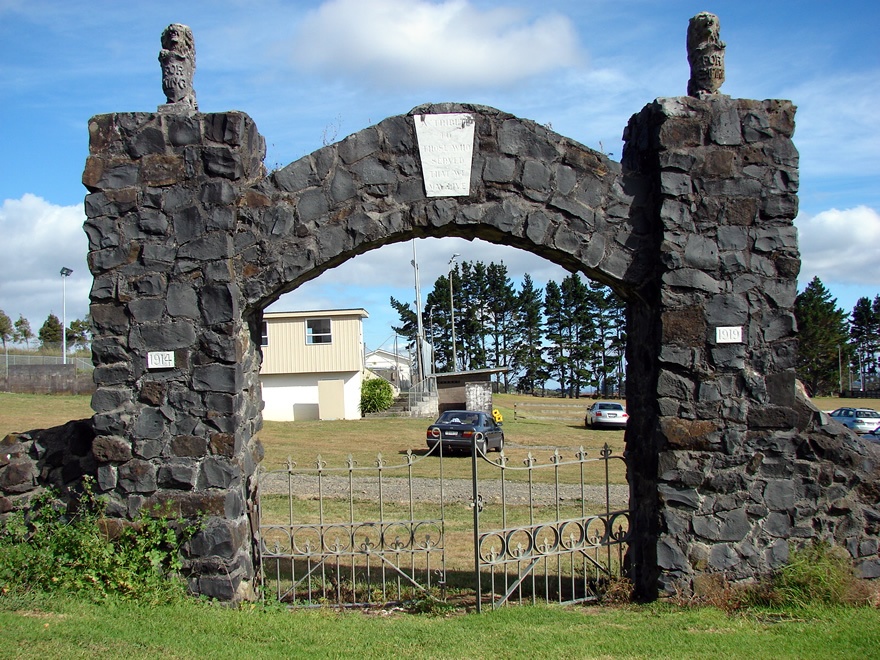
Bombay War Memorial Recreation Ground and adjacent memorials.
Bombay War Memorial Recreation Ground
On 22 November 1923 the Mayor of Auckland, Mr J.H. Gunson, opened the Bombay War Memorial Recreation Ground. The five-acre recreation ground included four tennis courts, a football field and a sports pavilion. Space was also set aside for a memorial garden. A stone arch with ornamental gates was set into a low stone wall that ran along the front of the recreation ground.
The pillars on either side of the arch were surmounted by two small carved stone lions bearing shields inscribed ‘For King’ (left) and ‘For Empire’ (right). A marble tablet at the centre bore the words ‘A tribute to those who served, that we might live’. Smaller tablets set into the pillars were inscribed ‘1914’ and ‘1918’.
The stone wall has long since disappeared. Over the years the memorial arch developed a perilous lean, but in 2015 local residents had it restored and rebuilt slightly further back from the road than its original site. In 2016 a Bombay roll of honour for both world wars was also put on display, listing the names given on the rolls of honour in the hall (see below). A boulder displaying a plaque which commemorated the presence of New Zealand and United States military camps in the area during the Second World War was also resited from near the hall to alongside the memorial.
Bombay School roll of honour
The Bombay memorial arch does not have any names inscribed. However, some time before its unveiling, the Bombay School First World War roll of honour had been unveiled at the local school, just across the road from the recreation grounds. This listed a total of 53 men who had seen active service, and one woman, Sister A. Mandeno. The roll of honour was later transferred to the Bombay hall. A list of 71 names was also published in the Bombay centennial history in 1965. The latter list included 24 dead (J. Barugh, T. Burgess, A. Carter, A.J. Carter, A.C. Evans, A.J. Evans, E. Fenton, A. Fitness, J. Fitness, P. Hancock, P.C.W. Hancock, R. Hancock, R.J. Hancock, R.G. Hanna, A. Kemp, R. Kemp, O. McGowan, T. Rudd, G. Scott, R. Shanahan, R.G. Strickett, J. Turvey, P. Wills, J.P. Wills).
The Paparata School, which was amalgamated with Bombay in 1944, once had its own First World War roll of honour, but this was destroyed by fire in 1965.
Bombay War Memorial Hall
After the Second World War the old Bombay hall, which stood next to the recreation ground, was restored and enlarged as a community war memorial. It was officially reopened as the Bombay War Memorial Hall on 7 November 1959.
The Bombay & Paparata Second World War roll of honour, a hand-written and hand-coloured scroll which had been compiled and donated by a local resident some years before, was re-set for the occasion. This listed a total of 90 soldiers, sailors, airmen and nurses who served overseas (a transcription of the names is found in the Bombay centennial history). The roll was accompanied by another framed board with photographs of nine men who died; two further photographs were also added to the original roll of honour.
The deceased were: Maurice S. (‘Hop’) Best, Bassett H. Carter, Kenneth (‘Ted’) Donovan, Doug Fletcher, J.R. (‘Jim’) Harris, J. Moffat [no photo], Colin Holmes, Ernest Howard, Dudley Murphy, Alan C. Stuart, Richard (‘Dick’) Whitmore, and J.B. Wilson,
The roll of honour has the signature of Sir Bernard Freyberg on the bottom right-hand corner—Sir Bernard signed it on a fleeting visit to the district in 1949.
These two boards hang in the hall, alongside the Bombay School First World War roll of honour, and near a set of four photographs taken at the opening of the hall.
Bombay School memorial trees
After the Second World War a number of memorial trees were planted outside the Bombay School headmaster’s house. These were accompanied by plaques commemorating five former pupils who had given their lives: L.A.C. Maurice Sydney Best , Pte. Kenneth Wilfred (Ted) Donovan, Stoker Jennings Douglas Marshall Fletcher, Sgt. Richard James Harris, and Pte. Colin Allenby Holmes. The plaques and trees are still in place today (along with two further memorial plaques unrelated to the war).
Sources: ‘Bombay War Memorial’, NZ Herald, 22/11/1923, p. 10; 'War Memorial: Unveiling at Bombay', Franklin Times, 23/11/1923, pp. 5, 8; ‘Bombay’s Tribute’, Auckland Star, 22/11/1923, p. 8; A. Donovan, They Came by Ship: Centenary of Bombay, 1865-1965, Bombay, 1965, pp. 35-41, 112-16; Bombay School 125th Jubilee, Bombay, 1997, pp. 18, 26















Community contributions